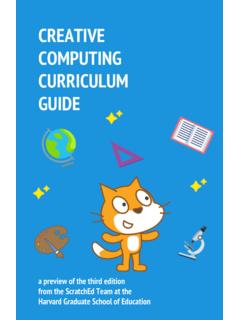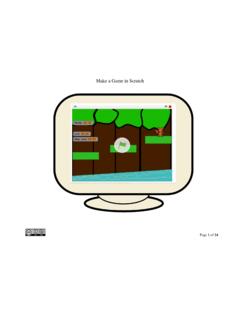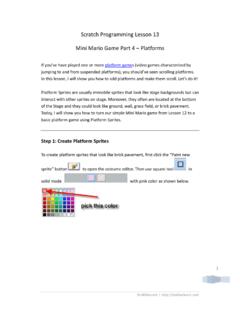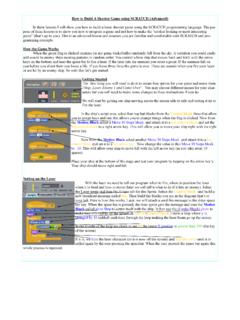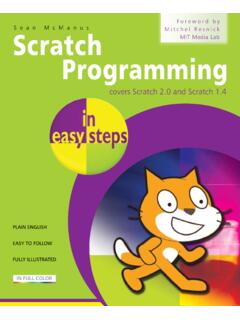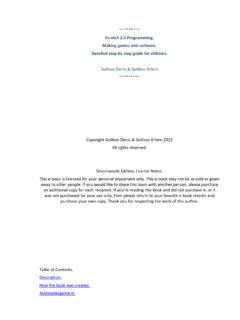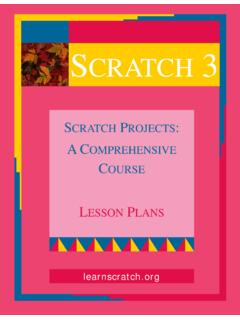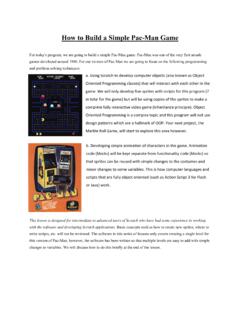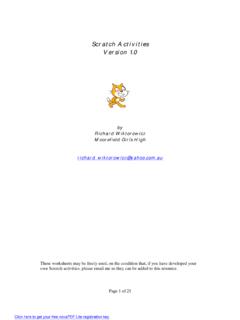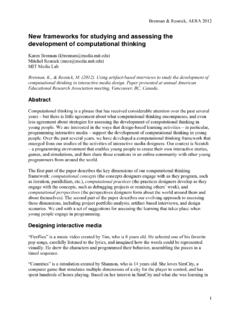Transcription of New frameworks for studying and assessing the …
1 Brennan & Resnick, AERA 2012 1 New frameworks for studying and assessing the development of computational thinking Karen Brennan Mitchel Resnick MIT Media Lab Brennan, K., & Resnick, M. (2012). Using artifact-based interviews to study the development of computational thinking in interactive media design. Paper presented at annual American Educational Research Association meeting, Vancouver, BC, Canada. Abstract Computational thinking is a phrase that has received considerable attention over the past several years but there is little agreement about what computational thinking encompasses, and even less agreement about strategies for assessing the development of computational thinking in young people. We are interested in the ways that design-based learning activities in particular, programming interactive media support the development of computational thinking in young people.
2 Over the past several years, we have developed a computational thinking framework that emerged from our studies of the activities of interactive media designers. Our context is Scratch a programming environment that enables young people to create their own interactive stories, games, and simulations, and then share those creations in an online community with other young programmers from around the world. The first part of the paper describes the key dimensions of our computational thinking framework: computational concepts (the concepts designers engage with as they program, such as iteration, parallelism, etc.), computational practices (the practices designers develop as they engage with the concepts, such as debugging projects or remixing others work), and computational perspectives (the perspectives designers form about the world around them and about themselves).
3 The second part of the paper describes our evolving approach to assessing these dimensions, including project portfolio analysis, artifact-based interviews, and design scenarios. We end with a set of suggestions for assessing the learning that takes place when young people engage in programming. Designing interactive media Fireflies is a music video created by Tim, who is 8 years old. He selected one of his favorite pop songs, carefully listened to the lyrics, and imagined how the words could be represented visually. He drew the characters and programmed their behavior, assembling the pieces in a timed sequence. Countries is a simulation created by Shannon, who is 14 years old. She loves SimCity, a computer game that simulates multiple dimensions of a city for the player to control, and has spent hundreds of hours playing.
4 Based on her interest in SimCity and what she was learning in Brennan & Resnick, AERA 2012 2 history class, she developed a simulation about virtual countries, with the player making decisions about how to respond to economic, agricultural, and political crises. 10 Levels is a game created by Renita, who is 10 years old, and her younger brother. She played a similar game on a popular game site and decided to design her own version of the game, which involves navigating the main character from the start of the level to the end of the level without colliding with hazards (such as spikes, fireballs, and trapdoors). All three of these projects were created by young people using Scratch, a computational authoring environment developed by the Lifelong Kindergarten research group at the MIT Media Lab.
5 With Scratch, young people can design their own interactive media including stories, games, animations, and simulations by snapping together programming-instruction blocks, just as one might snap together LEGO bricks or puzzle pieces (Resnick et al., 2009). In addition to the authoring environment, there is an online community where young people can share their projects, just as videos are shared on YouTube. The Scratch online community, which was launched in May 2007, has grown steadily over the past five years; hundreds of thousands of young creators (mostly between the ages of 8 and 16) have shared more than million projects. Community members can interact with projects (try them out, or download to see how they work) and with other members (leave comments, or mark someone as a friend) (Brennan, Resnick, & Monroy-Hernandez, 2010; Brennan, Valverde, Prempeh, Roque, & Chung, 2011).
6 Computational thinking How do we describe what Tim, Shannon, and Renita are learning as they participate as designers of interactive media with Scratch? What is the learning that is supported by programming interactive media, as opposed to making a video with editing software or playing a video game? We have been intrigued by the phrase computational thinking as a device for conceptualizing the learning and development that take place with Scratch. Although computational thinking has received considerable attention over the past several years, there is little agreement on what a definition for computational thinking might encompass (Allan et al., 2010; Barr & Stephenson, 2011; National Academies of Science, 2010). Cuny, Snyder, and Wing (2010) define computational thinking as the thought processes involved in formulating problems and their solutions so that the solutions are represented in a form that can be effectively carried out by an information-processing agent a description that aptly (if somewhat tersely) frames the work of computational creators.
7 The phrase computational thinking helps us think about learning with Scratch, and, in turn, we believe that programming with Scratch provides a context and set of opportunities for contributing to the active conversations about computational thinking. We are interested in the ways that design-based learning activities in particular, programming interactive media support the development of computational thinking in young people. Part of this interest is fuelled by the growing availability of tools that enable young people to design their own interactive media. But, more importantly, this interest is rooted in a commitment to learning Brennan & Resnick, AERA 2012 3 through design activities, a constructionist approach to learning that highlights the importance of young people engaging in the development of external artifacts (Kafai & Resnick, 1996).
8 Over the past several years, by studying activity in the Scratch online community and in Scratch workshops, we have developed a definition of computational thinking that involves three key dimensions: computational concepts (the concepts designers employ as they program), computational practices (the practices designers develop as they program), and computational perspectives (the perspectives designers form about the world around them and about themselves). Observation and interviews have been instrumental in helping us understand the longitudinal development of creators, with participation and project portfolios spanning weeks to several years, and workshops have been instrumental in understanding the practices of the creator-in-action. Computational thinking concepts As young people design interactive media with Scratch, they engage with a set of computational concepts (mapping to Scratch programming blocks) that are common in many programming languages.
9 We have identified seven concepts that are highly useful in a wide range of Scratch projects, and which transfer to other programming (and non-programming) contexts: sequences, loops, parallelism, events, conditionals, operators, and data. For each concept, we provide a definition of the concept and a concrete example from a Scratch project. Concept: Sequences A key concept in programming is that a particular activity or task is expressed as a series of individual steps or instructions that can be executed by the computer. Like a recipe, a sequence of programming instructions specifies the behavior or action that should be produced. For example, the cat object can be programmed to move a short distance across the screen and declare, I m programming! with the sequence of instructions shown in Figure 1.
10 Figure 1. Example of an instruction sequence. Concept: Loops In the previous example, the cat was programmed to move 10 steps, wait seconds, and then to repeat the action moving another 10 steps, and waiting another seconds. What if, instead Brennan & Resnick, AERA 2012 4 of a single repetition of the action, we want the cat to move and wait three more times? We could easily add more move and wait blocks. But what if we wanted the cat to move and wait 50 or 100 or 1000 more times? Loops are a mechanism for running the same sequence multiple times. Figure 2 illustrates how a loop can be used to express a sequence of instructions more succinctly. Instead of moving and waiting with 8 consecutive blocks, we use three blocks: move 10 steps, followed by wait secs, enclosed by repeat with the desired number of iterations.
